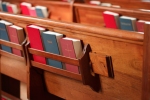September 2017
Stewardship
An “Endow your Pledge” Campaign
Endowing one’s pledge is the ideal way for some church members to support their beloved institution long after their passing. Creating an endowed pledge requires a parishioner to include adequate funds, explicitly designated for the church, in the member’s estate plans. The words “adequate funds” are defined as funds that would annually – in perpetuity – produce interest equivalent to their annual pledge. If, for example, a member’s annual pledge was $2,500, it would require a $50,000 gift in that person’s estate plans be directed to their church. Churches typically take a 4-5% annual payout from their endowment. (Note: If you embark on this campaign, I recommend using a chart in your communications. It would contain several examples and state: “If your pledge is $X then $Y would be required to endow your pledge.)
Because most people designate these funds to be paid upon their death, “endowing one’s pledge” should not be confused with the annual campaign where one pledges to give X dollars each year to support their church’s operating budget. Most churches depend heavily on the annual campaign to support each year’s mission and ministry. Estate gifts are typically placed in the church endowment and, while use of the endowment interest varies from church to church, most often these funds are spent on building maintenance. Many churches, including Calvary Pittsburgh where I serve, permit parishioners to specifically designate or restrict the use of their estate gift for purposes such as music, outreach, stained glass windows, or building maintenance.
Although the funds to endow one’s pledge are typically transferred to the church endowment upon a person’s death, occasionally members opt to give this gift during their lifetime. A major reason for this is that after age 70.5, when people are required to take a payout from their retirement funds, there are substantial tax benefits to giving some or all of the payout to a nonprofit.
If your parish is discussing a possible “Endow Your Pledge” campaign, please know that it’s not difficult. However, this campaign may not be as successful if it lacks context and a message that has been repeated frequently and resonates with your parishioners. Therefore, before embarking on this campaign, I highly recommend that you create a formal legacy society structure to acclimate your members with discussions about estate planning, opportunities for creating a legacy, and sustaining your church into the future.
Think of this campaign as one more tool in the planned giving toolbox. After your congregation is accustomed to hearing requests to remember the church in their will, the next biggest issue standing between you and a successful campaign is an effective marketing/communications plan. Your parishioners will need to understand the following salient points:
➢ What does endowing one’s pledge actually mean?
➢ How much money is needed to endow a pledge?
➢ How is this campaign different from the annual pledge campaign?
➢ Why is this campaign important?
➢ How will these gifts be used?
➢ Plus, additional information germane to your particular church should be explained.
After two active years of discussing our legacy society at several neighborhood cocktail parties/luncheons, articles in our newsletter and church bulletin, adult education programs, and more, Calvary Church launched an “Endow Your Pledge” campaign, accompanied by detailed information. Our marketing/communications included:
- In March 2016, every household received our legacy society brochure and letter announcing this campaign.
- Two weeks following our mailing, St. Michael’s Society (our legacy society) members spoke about this campaign to our congregation at each Sunday Eucharist.
- In April 2016, our campaign announcement letter was printed in our newsletter and the May newsletter contained an article explaining the different between our “Endow Your Pledge” campaign and our annual pledge campaign.
- In June 2016, a church member hosted a cocktail party, open to anyone who wanted to learn more about this campaign. Our August newsletter asked members to “Please Remember Calvary Church in Your Estate Plans.”
- An article in our October 2016 newsletter reminded parishioners that the active phase of this campaign would end December 31, 2016 and again explained why it was so important. Our November and December 2016 newsletters stated in large red letters: “Please Remember Calvary Church in Your Estate Plans.”
- In April 2017, every household received a campaign summary letter, describing the successful outcome and our newly updated legacy society brochure. This update stated that endowing one’s pledge was now a permanent, planned giving opportunity.
When we started the campaign many of the “usual suspects” were already members of our legacy society, so our goal was to add parishioners who have long been deeply involved in our church. The exciting news is that in addition to several members endowing their pledge, one family made a gift directly to the church’s endowment; three previously anonymous donors presented paperwork; and a member who left the state, pledged an estate gift. As of August 2017, our legacy society is 61 members strong - including those who have endowed their pledge - in a church with 350 pledge units. This society had only 41 members in early 2014 and four of these members have since died.
Our goal is to have 10%, or 35 pledge units, endow their pledge. However, I want to stress that, in all communications, we stated that we understand not everyone is able to endow their pledge and estate gifts of any size are greatly appreciated and will have a positive impact on Calvary’s future.
If you have any questions, please email me at dc1kelly@gmail.com
Deborah Kelly is the Planned Giving Chair at Calvary Church in Pittsburgh, PA.
Resources
- ECF Planned Giving services and resources
- Funding Future Ministry, a guide to planned giving
- Closing the Planning Gap by David Farrand, Vestry Papers, January 2011
- Basics of Planned Giving, an ECF webinar led by Jim Murphy, March 23, 2015
- Integrating Annual, Capital & Planned Giving, an ECF webinar led by Terri Mathes, October 1, 2014
- Starting Planned Giving From Scratch, a tool to help your congregation start from the ground up
- Creating a Legacy Society, a sample brochue and enrollment form for a legacy soceity
- How to Plan a "Final Affairs" Fair, a tool to help their members learn more about planned giving






